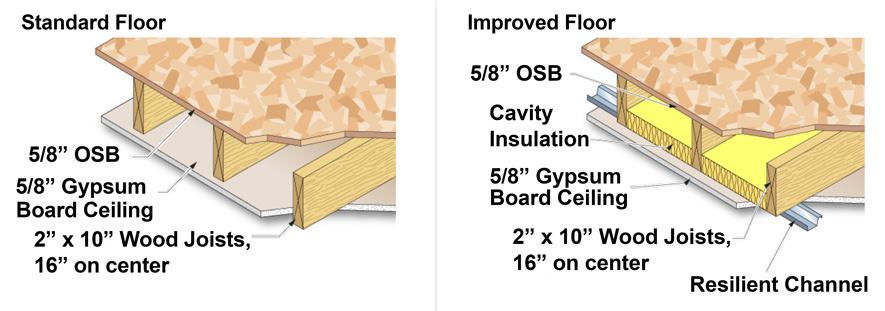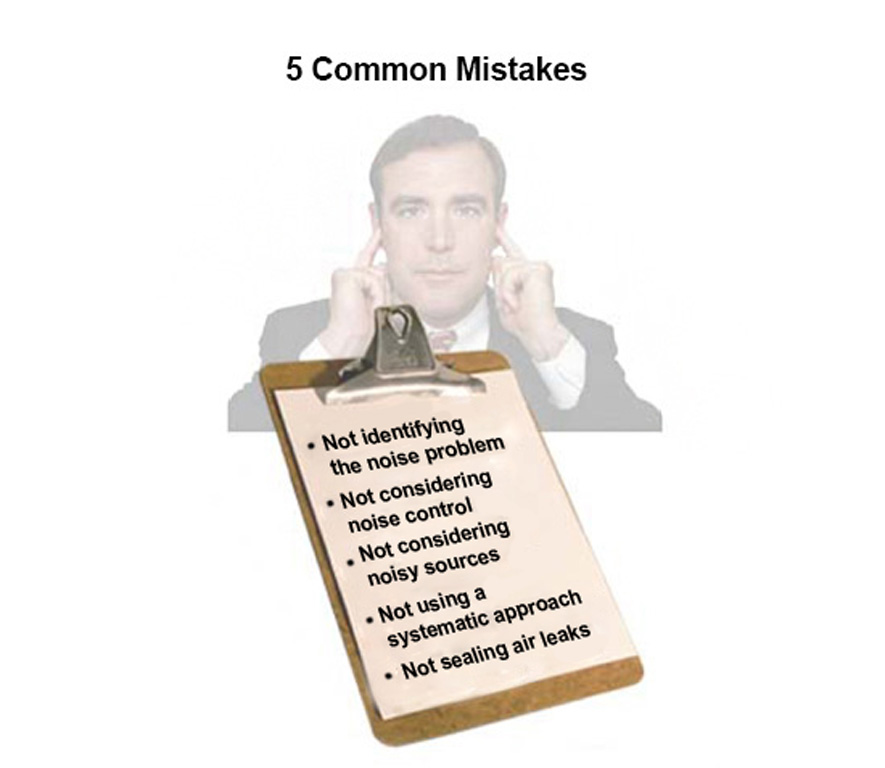Acoustical Control in Buildings
SOUND MITIGATION IN CEILINGS AND FLOORS
At the basic level, airborne sound can be attenuated in ceilings in a manner similar to walls by adding sound absorptive insulation in ceiling and floor systems, adding resilient channels, and additional gypsum board. In framed construction with floor/ceiling joists, the techniques and performance are similar to wall construction techniques. For suspended ceilings, some insulation is designed specifically to be used in the plenum space above to economically improve both noise control and possibly thermal performance in new or existing ceiling systems. When placed on top of a suspended ceiling at a floor-to-ceiling partition, this type of insulation has been shown to help reduce the transfer of sound over the partition between rooms. As such, it can improve the ceiling attenuation class (CAC) rating on the order of 4–10 points.

Images courtesy of CertainTeed Insulation
In multi-story buildings, the ceiling/floor assembly needs to address both IIC and STC equally with strategies that reduce both airborne and structure-borne sound.
In multi-story buildings, the ceilings are also a floor for the story above. The measures described, along with appropriate sealing, will still work very effectively in these cases for airborne sound. However, the sound transmitted due to impacts need to be addressed differently. In this case, a material is needed to reduce the transmission of sound from people walking, dropping things, or operational activities. In some cases, the flooring itself can help reduce sound, such as carpeting or cushioned vinyl flooring. However, that typically isn’t enough to address areas with a fair bit of activity. Rather, the most effective approach is to install a continuous layer of material with a high impact insulation class (IIC) rating between the subfloor and the finish flooring. Floor matting of this type is commonly composed of closed cell, extruded polyethylene foam, or ethylene propylene diene monomer (EPDM). It is acoustically engineered to reduce structure-borne sound by isolating it to the room in which it is created. By placing it between the subfloor and then installing a plywood or gypsum concrete layer on top, it creates a continuous layer to isolate impacts, dissipating some energy and reflecting the remainder back into the space above. The installed plywood or gypsum concrete layer “floats” on top of the floor mat, thus providing a rigid surface for the finished flooring.
To increase both the STC and IIC ratings of a floor/ceiling construction, fiberglass insulation should be installed in the joist cavity, with a resilient ceiling system below the joists for best results. The IIC rating of a floor/ceiling assembly should be equal to or better than its STC rating to achieve equal performance in controlling both airborne and structure-borne sound. As with partition and wall construction, penetrations in sound-rated floor/ceiling assemblies should be caulked airtight. Lighting fixtures and other items should be surface mounted, not recessed to avoid the penetration of the ceiling surface.
SOUND CONTROL IN MECHANICAL SYSTEMS
HVAC systems typically require ductwork to move air within the building for space conditioning or ventilation or both. From an acoustical standpoint, ductwork is a penetration in a wall or ceiling that has the potential to bring noise into a space. If not acoustically treated, noise from heating, ventilating, and air-conditioning equipment, such as fans and motors, can travel through the ductwork from room to room in a building. The velocity of the air in the duct system can cause noise-producing turbulence, while also causing turning vanes, dampers, and other elements inside the ducts, grilles, and diffusers to whistle or rattle. HVAC ductwork can also act as a “speaking tube,” acting as a means to carry conversations from one room or office into other spaces.
To reduce the noise from HVAC equipment, a good guideline is “lower and slower”: lower volumes of air moving through the system with fans and blowers operating at a slower speed will lower the source of the noise. Central air equipment should also be acoustically isolated from spaces where airborne noise would be objectionable. Equipment should be mounted on vibration isolators to avoid transmission of structure-borne noise. Sound traps or baffles will help to attenuate equipment noise in adjacent ductwork.


Images courtesy of CertainTeed Insulation
Fiberglass duct liner insulation provides substantial reduction of duct-borne noise (top), while fiberglass duct systems can provide superior sound deadening (bottom).
When it comes to the ductwork itself, recognizing that it can be a source of noise as well as a transmitter of it is important. Sheet metal ductwork without insulation can produce popping and banging noises due to expansion and contraction caused by changes in air temperature. The air turbulence in ductwork can also be problematic. Most of the ductwork noise problems can be solved with fiberglass duct insulation in either of two forms. First, a specifically designed fiberglass duct liner can be installed inside sheet metal ductwork to attenuate air rush and central equipment noise. This fiberglass duct liner has the added benefit of helping to control heat loss or gain through duct walls. Second, fiberglass duct board can be used to fabricate the ductwork. This approach combines acoustical/thermal insulation with a reinforced foil-kraft air barrier/vapor retarder, allowing a complete air-duct system to be created. Either of these approaches have been found to be effective ways to control sound in HVAC systems. Fiber glass ducts wraps, used as thermal insulation on the outside of sheet metal ducts, provide little acoustical benefit except by muffling the popping and banging noises when ducts undergo temperature changes.

Image courtesy of CertainTeed Insulation
By taking a proactive approach to acoustical design in buildings, common mistakes and problems can be avoided.
CONCLUSION
Architects and designers are well served when they take time in the design process to consider acoustical needs. By taking a proactive approach, there are a few simple steps to avoid common mistakes and help assure a successful outcome. First, recognize that the building may have a noise problem if acoustics aren’t addressed properly. In general, if communication is difficult because of noise, a problem exists. Second, consider noise control from the outset. Although a source of noise can be treated after construction is complete, it’s generally twice as expensive and half as effective compared with designing proper noise control in the first place. Third, conduct a detailed study of noisy equipment or other problem sources. In doing so, consider if the frequency range is typical or falls in the more easily transmitted lower ranges. Fourth, use a systems approach to noise control. A common waste of noise control dollars is the failure to consider all possible solutions and noise paths. To treat one noise source and not consider all possible noise sources could lead to unacceptable noise levels when a project is completed. The same is true if only one path of noise transmission is considered. All airborne and structure-borne noise paths must be studied. Fifth, seal air leaks. Sound always takes the easiest path around or through a barrier. Construction gaps or air leaks are by far the easiest way for sound to pass from one space to another. Combining this approach with the principles and strategies discussed, it is entirely possible to achieve a healthy, sustainable, indoor environment for buildings of all types.
Peter J. Arsenault, FAIA, NCARB, LEED AP is an architect and green building consultant who has authored more than 120 continuing education and technical publications as part of a nationwide practice. www.linkedin.com/in/pjaarch

|
CertainTeed Insulation |








